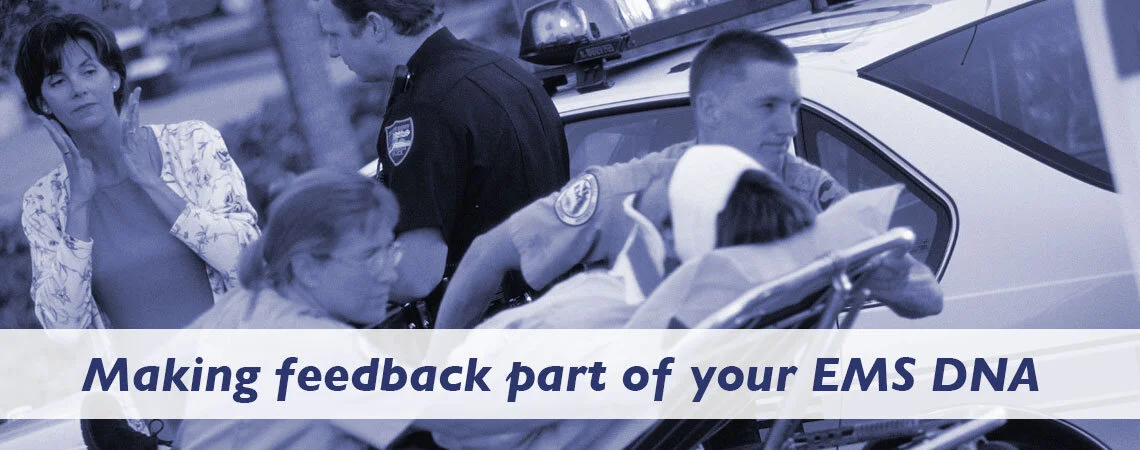Making feedback part of your EMS DNA
Feedback is a critical component of every successful EMS program. Because in this field, performance on the job can mean life or death for the patient.
Crew members need to know — in a timely manner — how they’re doing, what’s working and what’s not, in order to improve cardiac arrest outcomes.
When feedback becomes part of the process, your team can build on its shortcomings and celebrate its successes. While receiving feedback can create some fear and trepidation, done correctly, it really does improve survivability rates. And that’s what matters.
two types of feedback: in-the-moment and post-resuscitation
In-the-moment feedback is communicated during training or a live incident and can have an instantaneous effect as CPR is administered. It can be something as simple as correcting inaccurate hand placement or too-light compressions. Minor adjustments in those critical seconds could have a major impact.
Post-resuscitation feedback provides the opportunity for data to be scrutinized by multiple sets of eyes in varying roles, providing valuable input on how processes could be tweaked to improve results. Here in King County, for example, all resuscitation data is sent to the county for review. The county then provides a report to the EMS supervisor, who assesses the feedback and adds their own description before reviewing it with their crew. This type of feedback doesn’t single anyone out, but rather assesses the department as a whole to generate continuous improvement.
In the training setting specifically, feedback timing is flexible and can be adjusted as needed — two minutes into the drill, at the conclusion of the drill, etc. When using manikins or Simpads, everything is electronic so you can debrief and scroll through the data to review the different metrics with your crew. One student might have performed ventilations while another did compressions. You can evaluate both actions so the team can learn from each other — and get better doing it every time.
Feedback: The key to performance improvement
According to David Weed, Community Services Officer for Woodinville Fire and Rescue in King County, measuring performance allows you to see every nook and cranny of every flaw. So as a day of training progresses, crew members can take what they learn to make critical changes and improve their performance.
Says Weed, “By the end of the day, everyone is performing much better, and it’s due to that feedback at the end of every training scenario.”
When your crew is in the moment, they’re concentrating on the task at hand. But when you can walk them back through it, providing an assessment of their strengths and weakness, they’ll gain a clearer picture of improvement opportunities or receive positive affirmation that they’re meeting performance goals.
Tools of the trade for giving useful feedback
For training scenarios, the biggest tool in the toolbox is having feedback capability like a recording manikin or some type of feedback device. These resources can give you an objective, real-time view, revealing if a student is doing full chest compressions or going down deep enough for each compression. Once the drill is over, you can replay the scenario and show the student how they performed.
You may find that chest compressions, for example, slow down during the second minute of training, an indication that the CPR administrator was getting tired. This is an excellent teaching tool, exemplifying the effects of fatigue on CPR performance and the importance of having someone to take over compressions for the second half of administration.
When the drill is over, you and your crew can assess: How was the scene? Was it chaotic? What rhythms was the patient in? When did we pause? If you notice areas that can be improved, you can focus on those during the next drill.
Don’t have access to a feedback device? Don’t let that hold your team back.
Explains Weed, “You can set up a video camera and record your crew doing a resuscitation. Even though you don’t have a manikin to relay depth compressions, you can still focus on how your people worked together as a crew, the choreography of transitions between compressions, the overall feel of the drill and anything that could have been done to make the CPR administration cleaner and more efficient.”
For any EMS program, the goal is simple: to save more lives. And with the right feedback process in place, you’ll give your team the best chance to improve survivability, while giving cardiac arrest patients the best gift of all — a positive outcome.
The Resuscitation Academy











There are opportunities to significantly increase survival from out of hospital cardiac arrest. Implementation of existing standards and training programs for telephone CPR and high-performance CPR will do much to improve survival.